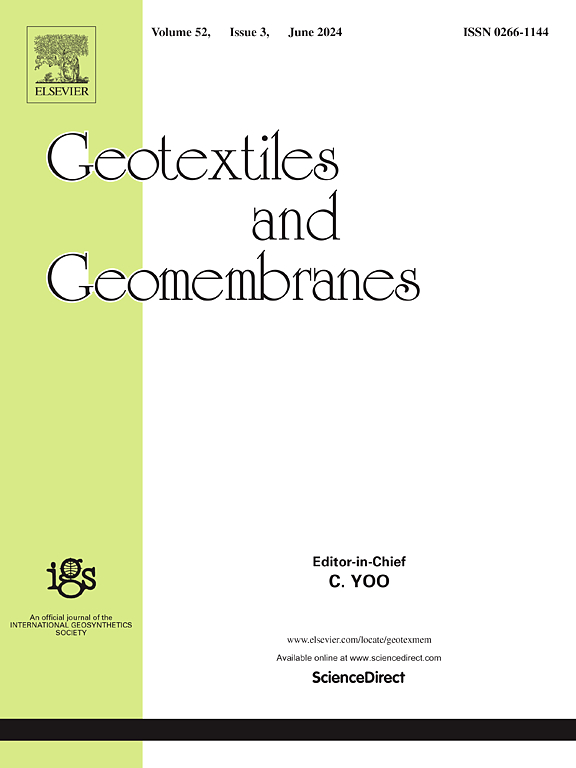Investigation on dewatering and reinforcement of dredged clay treated with SAP and PVD under vacuum preloading
IF 6.2
1区 工程技术
Q1 ENGINEERING, GEOLOGICAL
引用次数: 0
Abstract
This study investigates the dewatering and reinforcement performance of high-water-content dredged slurry using vacuum preloading combined with superabsorbent polymer (SAP) as a flocculant. Preliminary sedimentation experiments were conducted to compare the dewatering performance of different flocculants, and SAP was identified as the most effective additive for enhancing sedimentation. Laboratory vacuum preloading model tests were conducted on dredged clay treated with SAP and prefabricated vertical drain (PVD), to evaluate the effectiveness of SAP in enhancing the dewatering process. Results show that SAP enhances vacuum efficiency, leading to higher and faster vacuum pressure stabilization near the PVD. SAP-treated samples exhibited more rapid pore water pressure dissipation and accelerated water content reduction, particularly in the early stages. Post-treatment water content increased with distance from the PVD, but SAP improved overall drainage uniformity. Vane shear strength decreased with distance from the PVD but remained higher in SAP-treated samples, showing a linear correlation with normalized water content. SAP also influenced soil column formation, expanding its effective radius and reducing stabilization time. Two quantitative models were developed to predict shear strength and soil column radius variations under vacuum preloading with and without SAP. The radius of the soil column formed during vacuum preloading varied with depth, decreasing towards the bottom and increasing towards the surface. These findings provide valuable insights for optimizing vacuum preloading in dredged material treatment and soft soil improvement.
真空预压下SAP和PVD处理的挖泥脱水加固研究
研究了真空预压结合高吸水性聚合物(SAP)作为絮凝剂对高含水率疏浚浆的脱水增强性能。通过初步沉降试验,比较了不同絮凝剂的脱水性能,确定SAP是最有效的絮凝剂。通过实验室真空预压模型试验,对SAP和预制垂直排水管(PVD)处理的疏浚粘土进行了试验,以评价SAP对疏浚粘土脱水过程的改善效果。结果表明,SAP提高了真空效率,使得PVD附近的真空压力稳定速度更快。sap处理的样品表现出更快的孔隙水压力消散和加速的含水量降低,特别是在早期阶段。处理后的含水率随着与PVD距离的增加而增加,但SAP改善了整体排水均匀性。叶片抗剪强度随着与PVD的距离而降低,但在经过sap处理的样品中保持较高,与归一化含水量呈线性相关。SAP还影响了土柱的形成,扩大了有效半径,缩短了稳定时间。建立了两个定量模型来预测真空预压和不加SAP下土柱抗剪强度和半径的变化。真空预压形成的土柱半径随深度变化,向底部减小,向表面增大。这些研究结果为疏浚材料处理和软土改良中真空预压的优化提供了有价值的见解。
本文章由计算机程序翻译,如有差异,请以英文原文为准。
求助全文
约1分钟内获得全文
求助全文
来源期刊

Geotextiles and Geomembranes
地学-地球科学综合
CiteScore
9.50
自引率
21.20%
发文量
111
审稿时长
59 days
期刊介绍:
The range of products and their applications has expanded rapidly over the last decade with geotextiles and geomembranes being specified world wide. This rapid growth is paralleled by a virtual explosion of technology. Current reference books and even manufacturers' sponsored publications tend to date very quickly and the need for a vehicle to bring together and discuss the growing body of technology now available has become evident.
Geotextiles and Geomembranes fills this need and provides a forum for the dissemination of information amongst research workers, designers, users and manufacturers. By providing a growing fund of information the journal increases general awareness, prompts further research and assists in the establishment of international codes and regulations.
 求助内容:
求助内容: 应助结果提醒方式:
应助结果提醒方式:


